Introduction
In a press conference following the shooting, President Bill Clinton emphasized the importance of recognizing the warning signs in teenagers. President Clinton stated “Surely more of them can be saved and more innocent victims and tragedies can be avoided” Such warning signs President Clinton is referring to were overwhelmingly present in Klebold and Harris prior to the shooting, demonstrated through their respective journal entries, behavior patterns, and the Basement Tapes. However, what President Clinton failed to recognize, along with many others, was the presence of mental illness and mental health struggles Klebold and Harris were experiencing amid the various warning signs their behavior exhibited.
Though it cannot be attributed to the sole cause for the actions of Klebold and Harris, as that is still largely disputed today, the state of their mental health did play a key role in their actions. Klebold and Harris had no formal diagnosis for mental illness prior to the shooting. However, with investigations into the many warning signs and of Klebold and Harris’s behavior, psychologists ruled Harris a psychopath and Klebold was diagnosed with severe depression disorder. Psychologists also speculated that Klebold showed signs of schizotypal personality disorder. Klebold and Harris’ diagnosis only following the shooting suggests the lack of attention paid to the various warning signs their behavior exhibited, and additionally the lack of widespread mental health awareness at the time.
Journal Entries
On April 20th, 1999 at approximately 8:41 am, Eric Harris posted on an AOL chat room “Today is my last day on Earth”, indicating that he was planning to commit suicide after the shooting. Harris had been planning for the shooting for over a year, with evidence of aspirations for orchestrating a shooting visible in his journal entries. The journal entries Klebold and Harris wrote point to several significant warning signs. Klebold’s first journal entry was on March 30th, 1997, in which he refers to his depression on the front cover, and mentioned suicide. According to Dave Cullen, author of Columbine, Dylan’s journal entries were typically very systematic, with each entry dated and filling exactly two pages, with the same exact formatting. However, in the months leading up to April 1999, the entries became disorganized, “highly erratic”, with Klebold no longer keeping track of the dates. Klebold’s increasingly irregular journal entries reflect his struggle with depression worsening.

Entry from Klebold on April 15th, 1997 (courtesy of Dave Cullen)
Contrary to Klebold, the content of Harris’s journal entries consisted of more day to day entries consisting of his “private hopes and fears…long before he dreamed of murder” with no plans for violence, highlighting that Klebold did not foresee the shooting like Harris did. Harris’s journal was less traditionally kept and maintained. According to Cullen, it “focused on explaining Eric’s reasons and plans for mass murder. One significant entry Harris made was regarding his desire to top the events of the Oklahoma bombing, with him writing, “i want to leave a lasting impression on the world”.
Harris additionally made several allusions to wanting to orchestrate a shooting, with evidence of this dating back to April 1998, when he first began his journal. These initial differences between their journal entries serve to display the different motivations as well as mental health issues Klebold and Harris were experiencing. Though they came together for the shooting, they had different goals and things they were hoping to get out of it: with Harris in it for the joy of violence and destruction, while Klebold was depressed, looking for a way out of his internal struggles.

Harris’s rant about man kind, dated June 12, 1998. (courtesy of Dave Cullen)
Basement Tapes
Another significant warning sign of Klebold and Harris actions can be seen through the Basement Tapes, a series of videotapes Klebold and Harris made from March 15 to April 20, 1999. In the videos, they were “specifically addressing the attack they had planned”, expressing their reasons for the attack. While all of the tapes have been officially destroyed, a report of the tapes created by Jeffco Sheriff (Coloradan sheriff department) Ted Mink exists. In this report, Harris referred to the attack as the “suicide plan”, and the tapes consist largely of Harris and Klebold showing off their various weapons, from pipe and propane bombs to automatic rifles.
Sue Klebold, Dylan Klebold’s mother, recalled in her memoir, ‘A Mother’s Reckoning’ when Eric would come over. “… and we remembered when Eric spent the night and he had brought a big duffel bag in and we had just assumed it was, I don’t know, perhaps a video camera or a computer ….and we had to sort of put these pieces together of what the boys had been doing that night, and it was a complete shock.” This demonstrates how overlooked Harris and Klebold’s actions were; they seemed like normal teenage boys, though if Sue Klebold had looked further, she may have been able to recognize the warning signs.

‘A Mother’s Reckoning: Living in the Aftermath of Tragedy’ by Sue Klebold (image courtesy of NPR)
Conclusion
The disturbing warning signs of Klebold and Harris illustrate the need for the stigma surrounding mental illness to be broken down. Had Klebold and Harris been able to get the help they need, would the shooting have even happened in the first place? Had Sue Klebold one night decided to check on Eric and Dylan while in their basement, would things have turned out differently? Contemplating the what-ifs in disaster can become dangerous, obsessive. However, there is no denying how Klebold and Harris’ mental health was a warning sign in itself, reflecting the need for greater support to be provided to teenagers, even when they seem completely normal. This highlights the many interesting themes of Columbine in which many important questions are raised surrounding American culture. Such questions beg the need to fully embrace the issues of mental health awareness and education as well as school shootings and gun violence within society, to be able to foster true change.